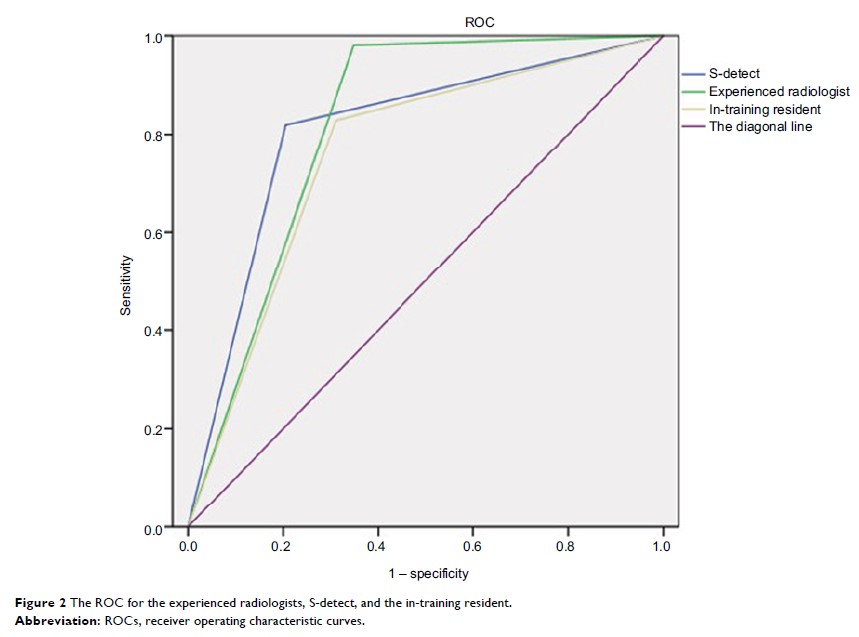9 0 6 7 6
论文已发表
注册即可获取德孚的最新动态
IF 收录期刊
- 2.6 Breast Cancer (Dove Med Press)
- 3.9 Clin Epidemiol
- 3.3 Cancer Manag Res
- 3.9 Infect Drug Resist
- 3.6 Clin Interv Aging
- 4.8 Drug Des Dev Ther
- 2.8 Int J Chronic Obstr
- 8.0 Int J Nanomed
- 2.3 Int J Women's Health
- 3.2 Neuropsych Dis Treat
- 4.0 OncoTargets Ther
- 2.2 Patient Prefer Adher
- 2.8 Ther Clin Risk Manag
- 2.7 J Pain Res
- 3.3 Diabet Metab Synd Ob
- 4.3 Psychol Res Behav Ma
- 3.4 Nat Sci Sleep
- 1.9 Pharmgenomics Pers Med
- 3.5 Risk Manag Healthc Policy
- 4.5 J Inflamm Res
- 2.3 Int J Gen Med
- 4.1 J Hepatocell Carcinoma
- 3.2 J Asthma Allergy
- 2.3 Clin Cosmet Investig Dermatol
- 3.3 J Multidiscip Healthc

乳腺超声图像作为一种计算机辅助诊断的可行性:关于中国单一中心 S-detect 诊断性能的结论
Authors Zhao C, Xiao M, Jiang Y, Liu H, Wang M, Wang H, Sun Q, Zhu Q
Received 15 October 2018
Accepted for publication 17 December 2018
Published 23 January 2019 Volume 2019:11 Pages 921—930
DOI https://doi.org/10.2147/CMAR.S190966
Checked for plagiarism Yes
Review by Single-blind
Peer reviewers approved by Dr Amy Norman
Peer reviewer comments 2
Editor who approved publication: Dr Chien-Feng Li
Objective: To
investigate the feasibility of a CAD system S-detect on a database from a
single Chinese medical center.
Materials and methods: An
experienced radiologist performed breast US examinations and made assessments
of 266 consecutive breast lesions in 227 patients. S-detect classified the
lesions automatically in a dichotomous form. An in-training resident who was
blind to both the US diagnostic results and histological results reviewed the
images afterward. The final histological results were considered as the
diagnostic gold standard. The diagnostic performances and interrater agreements
were analyzed.
Results: A total
of 266 focal breast lesions (161 benign lesions and 105 malignant lesions) were
assessed in this study. S-detect had a lower sensitivity (87.07%) and a higher
specificity (72.27%) compared with the experienced radiologist (sensitivity
98.1% and specificity 65.43%). The sensitivity and specificity of S-detect were
better than that of the resident (sensitivity 82.86% and specificity 68.94%).
The AUC value of S-detect (0.807) showed no significant difference with the
experienced radiologist (0.817) and was higher than that of the resident
(0.758). S-detect had moderate agreement with the experienced radiologist.
Conclusion: In this
single-center study, a high level of diagnostic performance of S-detect on 266
breast lesions of Chinese women was observed. S-detect had almost equal
diagnostic capacity with an experienced radiologist and performed better than a
novice reader. S-detect was also distinguished for its high specificity. These
results supported the feasibility of S-detect in aiding the diagnosis of breast
lesions on an independent database.
Keywords: ultrasonography,
breast neoplasms, image interpretation, computer-assisted, diagnostic imaging
